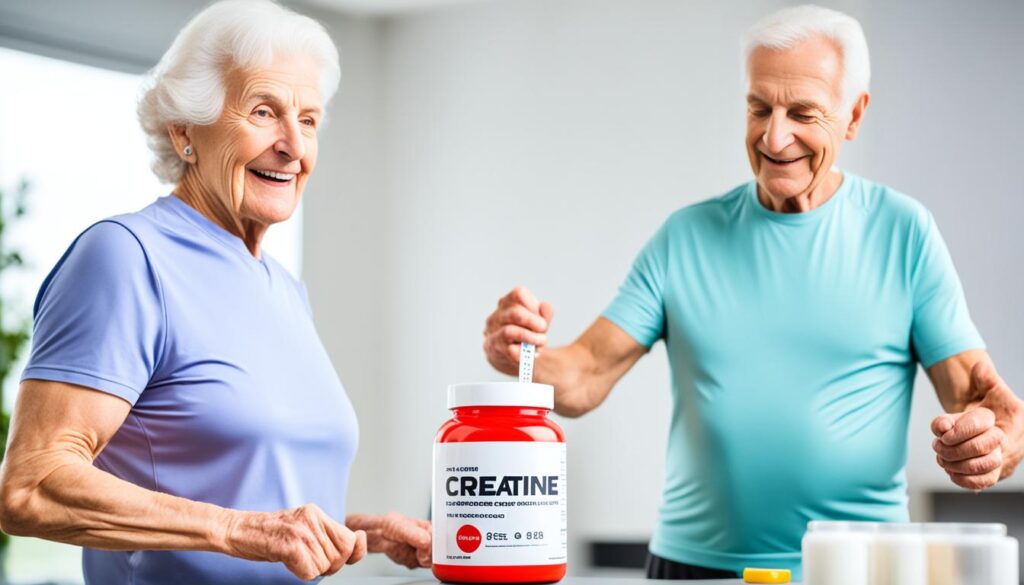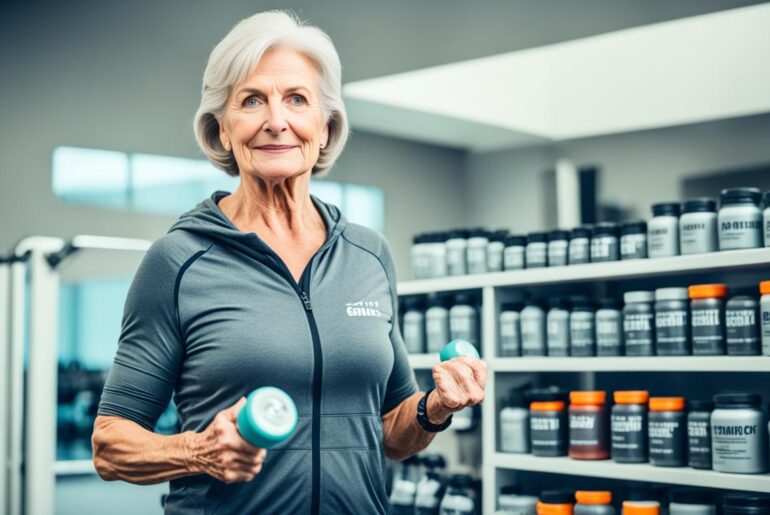Did you know that one in three adults over the age of 50 is at risk of sarcopenia-related fatigue? As we delve into the potential of creatine as an energy supplement, we uncover its pivotal role in helping aging adults combat fatigue. Intriguing research suggests that creatine isn’t just for athletes—it’s becoming a critical ally for seniors aiming to maintain muscle function and vitality.
Key Takeaways
- Creatine may help mitigate sarcopenia, which is associated with muscle weakness and fatigue in the elderly.
- Research indicates that creatine can improve muscle strength and endurance, important for aging adults.
- As an energy supplement, creatine has shown potential in enhancing the quality of life for seniors.
- Supplementation of creatine could play a significant role in the daily lives of older adults, helping them stay active and energized.
- Exploring the benefits of creatine is essential for those seeking methods to combat fatigue associated with aging.
Understanding Creatine and Its Role in Energy Metabolism
As a natural compound playing a vital role in the energy systems of our bodies, creatine is a subject of much interest, particularly regarding its ability to enhance ATP production and support increased muscle strength and cognitive function. The profound impact that creatine can have as an energy supplement makes it a substance worth understanding in depth.
The Science of Creatine and ATP Production
The relationship between creatine and ATP production is foundational to its role as a pivotal component in cellular energy creation. ATP, adenosine triphosphate, is the energy currency of the cell, and creatine helps to replenish ATP stores by donating a phosphate group during high-energy demands. This process is essential for maintaining ATP levels and, by extension, our muscle strength and overall energy endurance.
How Creatine Supplementation Works
Supplementing with creatine increases the phosphocreatine reserves in our muscles. These reserves are then utilized to produce ATP during intense, short-duration activities such as lifting weights or sprinting. By boosting the availability of phosphocreatine, creatine effectively acts as a quick energy source, which not only can enhance physical performance but also has been linked to improved cognitive function.
Scientific literature, such as the works of Brosnan et al. and Ydfors et al., has demonstrated this two-fold action, showing how dietary creatine contributes to muscle mass and endurance as well as the efficiency of muscle mitochondrial respiratory control. By sustaining elevated intramuscular creatine levels, individuals can potentially improve both muscular and mental performance, especially aging adults who are combatting the natural decline of these functions.
Whether you’re seeking to maintain high levels of cognitive activity or aiming to support your muscle strength as you age, understanding the intricate role of creatine in your body’s energy metabolism is the first step in making informed decisions about supplementation and diet.
The Impact of Aging on Muscle Strength and Endurance

As we age, our bodies naturally undergo a series of changes influenced by factors such as lifestyle, genetics, and environmental conditions. Of these changes, the decline in muscle strength and endurance has been of particular concern, especially among aging adults. Known as sarcopenia, this age-related muscle degradation poses a significant risk to senior health, often leading to reduced physical capability and a diminished quality of life.
Correlation Between Aging and Decreased Muscle Mass (Sarcopenia)
Profoundly studied by researchers like Cruz-Jentoft et al. and Dent et al., sarcopenia is identified as the progressive loss of muscle mass and strength as a direct result of aging. These studies underline a troubling trend: as individuals grow older, muscle deterioration accelerates unless counteractive measures are taken. Such insights are crucial, as they guide interventions to conserve muscle strength and endurance in the elderly population.
Fatigue and Energy Deficiency in Senior Health
The presence of fatigue and energy deficiency among seniors can often be traced back to the insidious onset of sarcopenia. My aim here is to shed light on the nuances of this condition, not just as part of the aging process but as a distinct health issue that can and should be addressed. It’s about enhancing quality of life by understanding the capabilities and limitations associated with changes in senior health.
| Aspect of Sarcopenia | Impact on Aging Adults | Intervention Strategies |
|---|---|---|
| Loss of Muscle Mass | Decreased physical functionality, increased risk of falls | Resistance training, protein supplementation |
| Reduction in Muscle Strength | Challenges in performing daily tasks, reduced independence | Targeted exercise programs, nutritional adjustments |
| Endurance Decline | Fatigue in prolonged activities, limited social participation | Gradual increase in activity levels, managed lifestyle choices |
Bolstering methods to maintain and rejuvenate muscular health in aging adults not only addresses the physical detriments of sarcopenia but also contributes significantly to preserving independence and enhancing overall well-being. As such, combating sarcopenia is not just about longevity but about enriching the later stages of life with vigor and vitality.
Benefits of Creatine for Aging Adults beyond Sports Nutrition
Often associated with performance enhancement in athletes, creatine is increasingly recognized for its benefits in senior health and daily function. What many don’t realize is that the perks of this multifaceted supplement extend into the realm of everyday wellness for aging adults.
Improving Daily Function with Creatine
My exploration into the world of sports nutrition has unveiled that creatine is not just for those looking to optimize their time in the gym. Rather, this powerful compound has shown promising results in assisting aging adults with tasks we often take for granted. One can’t help but be impressed by how something typically confined to the realm of sports can impact one’s ability to carry groceries, ascend stairs, and engage in social activities with added vigor and stability.
Studies on Creatine’s Efficacy for Seniors
Turning to the scholarly work of Forbes et al., and Candow et al., illuminates the role of creatine in enhancing muscular strength and exercise outcomes in the elderly. Moreover, Chilibeck et al. and Devries & Phillips present irrefutable evidence highlighting creatine’s impact on lean tissue mass and muscular strength amongst seniors. These findings aren’t just numbers on a chart—they narrate a story of renewed independence and improved quality of life.
In our quest for sports nutrition solutions that transcend the athletic sphere to benefit aging adults, creatine emerges as a beacon of hope, potentially reshaping the landscape of senior health and daily function.
Creatine to Combat Fatigue in Aging Adults

As we unravel the complexities of aging, it’s clear that fatigue stands as a formidable challenge, often diminishing the zest for life that many seniors wish to uphold. My investigative journey has led me to a consistent ally in this endeavor—creatine. Renowned researchposits that this impactful energy supplement addresses the fatigue conundrum head-on. To complement this narrative, an arresting image encapsulates the essence of vitality that creatine can bring to aging adults:
The work of Gualano et al. has been a cornerstone, unveiling the wide spectrum of creatine’s attributes. Notably, combatting fatigue surfaces as a prime benefit, alongside observable increments in body mass and muscle strength. Findings have been bolstered by pioneers like Kreider et al. and Hultman et al., who have meticulously chronicled creatine’s adeptness at elevating the performance of high-intensity functions—fundamental exercises that often become taxing as one advances in years.
Indeed, the prospect of integrating creatine into one’s lifestyle has gathered momentum among those aspiring to transcend the bounds of age-related fatigue. It is this synthesis of scholarly evidence and real-world application that mirrors the pronounced need for a pragmatic approach toward maintaining the dynamism of later years.
Allow me to outline with clear emphasis the key takeaways from the pioneering research:
- **Creatine empowers muscle strength**, a critical component in countering the gradual loss associated with age.
- **Resistance to fatigue** is evident with regular creatine use, a testament to its efficacy as an energy enhancer.
- In the arena of **high-intensity tasks**, creatine’s contribution to performance is nothing short of transformative.
In accordance, these facets collectively forge a path to a more spirited existence for seniors, underpinned by the science-backed potential of creatine. It’s an energized chapter I’m keen on sharing, where fatigue no longer casts a shadow over the golden years, thanks to this rapidly evolving field of supplementation.
Creatine’s Influence on Cognitive Function in the Elderly
In my exploration of creatine’s multifaceted benefits, it is fascinating to see its potential impact not just on physical health but also on the cognitive function of aging adults. The research I’ve delved into, particularly the work done by Rawson et al., presents compelling evidence for creatine’s role in memory improvement and overall cognitive enhancement for seniors.
As we age, our bodies face a natural decline in mental acuity, and the search for nutrients that can bolster cognitive health becomes critical. Creatine stands out as a promising candidate. Emerging studies suggest a correlation between creatine supplementation and heightened cognitive functions, even under the metabolic stresses caused by insufficient sleep.
Moreover, the implications for creatine in mitigating cognitive decline are profound. Regular intake of this supplement could be a key strategy for aging individuals to not only maintain but also rejuvenate their mental capabilities. This aligns perfectly with my focus on suggesting interventions to help maintain an optimal quality of life for my readership.
Using creatine to enhance cognitive function is increasingly supported by science, positioning it as more than just a muscle-building aid but also as a cognitive enhancer for aging adults.
Your take on this subject might be skeptical, and I understand that. It’s crucial to consider all aspects of a supplement before endorsing its use for something as significant as cognitive health. That’s why I constantly keep an eye out for the latest research, ensuring that the benefits are not just theoretical but backed by solid scientific evidence.
It’s essential to highlight that while creatine is well-known for its benefits in sports nutrition, its implications for cognitive health could make it a valuable component in the dietary regimen of seniors aiming for memory improvement and cognitive preservation.
- Creatine supplementation may improve mental performance in tasks requiring speed of processing.
- Studies have observed acute improvements in cognitive function following creatine intake, even in healthy adults.
- Long-term creatine usage could offer protection against neurological decline.
Ensuring that our aging population has access to information on how to maintain cognitive health is part of my commitment to my readers. The exploration of supplements such as creatine is integral to this mission, as it may offer a beacon of hope for those concerned about mental decline.
In conclusion, the research so far is quite promising and suggests that creatine could very well be a key supplement for improving cognitive function in aging adults. By keeping these findings in mind, my readers may find creatine to be a useful ally in their quest for sustained mental vigour and memory preservation.
Synergistic Effects of Creatine and Resistance Training

Resistance training stands out as a highly effective tool for combating muscle loss in aging adults, facilitating the development of a robust framework capable of reversing the degenerative effects of sarcopenia. Combined with the proven benefits of creatine supplementation, this powerful pairing underscores a pragmatic approach to mitigating muscle loss that plagues seniors worldwide. I will explore how integrating these two elements can enhance muscle strength and help fend off fatigue.
Resistance Training’s Role in Reversing Age-Related Muscle Loss
In the pursuit of reversing age-related muscle loss, resistance training has been recognized for its indispensable role. Notable studies have documented that engaging in regular resistance exercises can help halt, and in some instances, reverse the progression of sarcopenia — the involuntary loss of muscle mass and strength due to aging. The transformation in muscle fiber composition and neuromuscular engagement empowers aging adults to retain a critical measure of independence and daily functionality, marking resistance training as an essential practice for encouraging vitality among seniors.
Combining Creatine and Exercise for Enhanced Results
When it comes to amplifying the results of resistance training, creatine emerges as a complementary force. Its ingestion can significantly boost the muscle’s reservoirs of phosphocreatine, essential for high-intensity physical activity. The combination of creatine and resistance training synergistically works to enhance muscle hypertrophy and strength, presenting a solid strategy to combat fatigue and muscle loss in aging adults. The resultant enhancements in lean body mass and endurance open up new possibilities for aging individuals to lead more dynamic lives.
| Intervention | Benefits | Impact on Aging Adults |
|---|---|---|
| Resistance Training Alone | Increases muscle strength and endurance | Improves functional capacity and reduces muscle atrophy |
| Creatine Supplementation Alone | Enhances phosphocreatine stores, combats fatigue | Boosts muscle mass and cognitive function |
| Combination of Both | Amplifies strength gains, endurance, and muscle recovery | Significantly combats sarcopenia, enhancing overall quality of life |
Exploring Natural Sources of Creatine in Diets

As we age, our bodies’ ability to synthesize creatine declines, making dietary and supplemental sources more crucial. The journey to bolstering creatine stores in our bodies involves understanding both natural sources of creatine and the role of supplemental creatine. This is especially pertinent for aging adults looking to maintain muscle mass and cognitive function.
Dietary Intake vs. Supplemental Creatine
From the platters of our meals to the supplements in our medicine cabinets, creatine is accessible in various forms. My investigation into the subject reveals a vital distinction between ingesting creatine naturally through diet and opting for synthesized supplements. Insightful research highlights that the natural dietary intake of creatine typically comes from creatine-rich foods such as red meats and seafood, offering not only creatine but also a synergy of other essential nutrients. In contrast, supplemental creatine, often in the form of creatine monohydrate, provides a more direct and concentrated dosage form.
Best Creatine-Rich Foods for the Elderly
Among dietary options, certain foods stand out as robust repositories of creatine. These are integral to developing a creatine-rich diet, particularly for older adults seeking to enhance their nutritional profiles as they combat age-related muscle degradation:
| Food | Creatine Content | Additional Benefits |
|---|---|---|
| Beef | Approximately 1.8g per pound | Rich in protein and iron |
| Pork | Approximately 2g per pound | High in vitamins B6 and B12 |
| Fish | Approximately 1-2g per pound | Omega-3 fatty acids for heart health |
It’s worth noting, the integration of such creatine-laden foods within an aging adult’s diet contributes to their overall wellbeing. Specifically, red meats are an efficient natural source of dietary creatine. However, considering the potential for high cholesterol and saturated fat, balance and moderation should be paramount in the dietary decisions of older adults.
Guidelines for Creatine Dosage in Aging Populations

Navigating the appropriate creatine dosage for aging adults is a matter of balancing efficacy with safety. My investigation into this matter is informed by the findings of Gotshalk et al., and Candow & Chilibeck. These researchers present dosage parameters designed to enhance muscle strength and serve as an effective energy supplement for older individuals.
As a body ages, the muscle composition and the body’s ability to recover changes, making smart supplementation crucial. Below is a thoughtful approach towards creatine dosage, specifically tailored for older adults, marrying academic insights with practical applications:
| Age Group | Loading Phase (5-7 days) | Maintenance Phase |
|---|---|---|
| 65-74 Years | 0.3 g/kg/day | 3-5 g/day |
| 75 Years and Above | Seek physician guidance | 2-4 g/day |
It’s pertinent to remember that while the loading phase can be an effective means to quickly raise creatine levels in the muscles, it’s not a necessity for everyone, especially for seniors. The maintenance phase ensures a sustained creatine level conducive to ongoing muscle support.
As always, these guidelines are a starting point. Personal health conditions, existing dietary creatine intake, and overall nutritional status are critical factors that impact creatine supplementation needs. Consequently, it’s advisable for individuals to consult with healthcare providers to tailor a creatine regimen that aligns with their unique health profile.
“Optimal creatine dosage for aging adults should be reflective of the individual’s health status, dietary patterns and physical activity levels. The goal is to support muscle strength and act as a robust energy supplement while ensuring safety and tolerability.” – Candow & Chilibeck
Integrating creatine into the diet of elderly individuals can indeed be a strategic move for upholding their vitality. A mindful dosage of this supplement potentially offers a safe and effective method for improving quality of life among our aging population.
Safety Profile and Addressing Common Concerns on Creatine Use
In my extensive review of creatine’s use in aging populations, I’ve encountered numerous perspectives concerning its safety profile and the medical considerations that accompany its supplementation. The expansion of this nutrient in the wellness routine of older adults has brought forth a critical analysis of the facts versus fiction surrounding creatine myths. In rendering an account of such misapprehensions against the robust evidence provided by real-world research, I aim to clarify the genuinely promising role creatine can play in sustaining senior health.
Debunking Creatine Myths for Older Adults
One aspect of my fact-finding mission on creatine involves unraveling myths that have permeated the psyche of aging individuals. Indeed, scholars such as Kreider et al. have gone to great lengths to underline creatine’s benignity and overall effectiveness. These findings not only align with my own interpretations but also catalyze a shift in how seniors perceive the relationship between creatine use and the myriad benefits it promises. As we peel back the layers of misconception, the substantiated safety profile of creatine crystallizes, presenting itself as an asset rather than a liability.
Medical Considerations and Creatine
Medical considerations always take precedence, especially when discussing supplements for aging adults. The research works of Gualano et al., and Rawson et al., contribute significantly to the dialogue around proper creatine administration in geriatric populations. My critical exploration into these studies cements my understanding and advocacy for informed decisions backed by scientific proof. It becomes clear that when accurate medical considerations are applied, creatine emerges not as a subject of trepidation, but as a cornerstone supplement with the potential to remarkably enhance the health regime of seniors.
FAQ
How does creatine help combat fatigue in aging adults?
Creatine helps to combat fatigue in aging adults by increasing the availability of ATP, the primary energy carrier in our cells, which is especially important during activities requiring rapid energy production. This can lead to improved muscle strength, better endurance, and enhanced cognitive function, reducing the sensation of fatigue and increasing overall energy levels.
What is the role of creatine in energy metabolism?
Creatine plays a critical role in energy metabolism by serving as a reserve of phosphates in muscle cells, which are necessary to regenerate ATP. ATP is the molecule the body uses for energy, and during high-intensity, short-duration exercises, creatine phosphate is converted to produce more ATP, thereby sustaining energy production and muscular performance.
Can creatine supplementation improve cognitive function in aging adults?
Yes, studies have indicated that creatine supplementation may enhance cognitive function in aging adults. Creatine can provide energy to the brain and help maintain its function, potentially aiding memory improvement and other cognitive processes, especially under situations of metabolic stress.
What is the correlation between aging and decreased muscle mass (sarcopenia)?
The correlation between aging and decreased muscle mass, known as sarcopenia, involves the natural decline of muscle fibers and muscle strength as we age. Factors such as reduced physical activity, changes in hormone levels, and nutritional deficiencies contribute to this process. Sarcopenia can lead to a significant decrease in muscle strength and endurance, impacting overall senior health.
How does fatigue present itself in senior health, and how can it be addressed?
Fatigue in senior health often presents as a decline in energy and endurance, increased difficulty performing daily tasks, and a general feeling of tiredness. It can be addressed through a combination of diet, exercise, and nutritional supplements like creatine, which together can enhance muscle performance and contribute to a more energized state of being.
What are some benefits of creatine for aging adults beyond sports nutrition?
Beyond sports nutrition, creatine benefits aging adults by improving muscle function and daily life activities, aiding in the maintenance of lean tissue mass, increasing muscular strength, improving mobility, and potentially enhancing cognitive abilities. This improved functionality can lead to a better quality of life for seniors.
The synergy between creatine and resistance training in combating age-related muscle loss lies in their combined effect on muscle composition and strength. Resistance training stimulates muscle growth and increases strength, while creatine provides the necessary energy to improve performance during workouts and assists in muscular recovery. Together, they can effectively reverse some effects of sarcopenia.
How does dietary intake of creatine compare to supplemental creatine?
Dietary intake of creatine, primarily from sources like red meat and fish, contributes to the natural creatine stores in the body. However, as one ages, dietary sources may not be enough to maximize the creatine levels in the muscles. In contrast, supplemental creatine typically in the form of creatine monohydrate, provides a more concentrated dose that can significantly enhance muscle stores, endurance, and strength, especially beneficial for aging adults.
What creatine-rich foods should aging adults focus on including in their diets?
Aging adults should focus on including creatine-rich foods such as red meats, fish, and poultry in their diets. These foods naturally contain creatine, although the concentration is much lower compared to supplemental forms. Including these foods can help to maintain baseline creatine stores in the body.
What are the guidelines for creatine dosage in aging populations?
Guidelines for creatine dosage in aging populations typically suggest a loading phase followed by a maintenance phase. The loading phase usually consists of 15-20 grams of creatine per day, divided into several doses for 5-7 days. The maintenance phase involves 3-5 grams per day. However, it’s important for aging individuals to consult with healthcare professionals before starting any supplementation program to tailor the dosage to their specific health needs.
How safe is creatine for older adults to use?
Creatine is generally safe for older adults to use when taken appropriately. Clinical studies have shown that short and long-term supplementation with creatine is well-tolerated in aging populations. However, individuals with preexisting kidney conditions or those on certain medications should consult with a healthcare professional before starting supplementation.
What are some common myths about creatine that older adults should be aware of?
Some common myths about creatine include concerns about kidney damage, dehydration, and cramping. However, extensive research has demonstrated that creatine supplementation is safe and does not cause these issues when consumed as directed by individuals with healthy kidneys. Moreover, there is no scientific evidence that creatine negatively affects hydration status or causes cramps.
Are there any specific medical considerations for aging adults taking creatine?
Medical considerations for aging adults taking creatine include monitoring kidney function, reviewing potential interactions with medications, and assessing individual health conditions. It’s crucial for older adults to speak with their healthcare provider to ensure that creatine supplementation is appropriate for their particular health profile.




